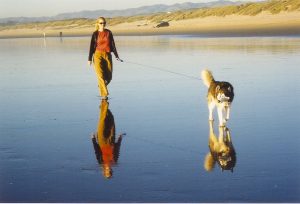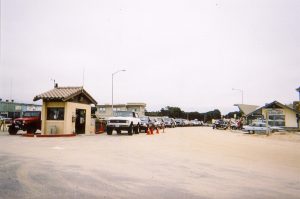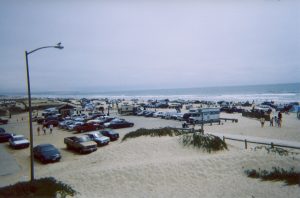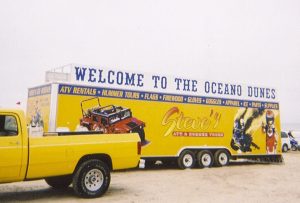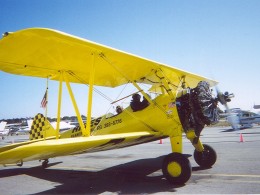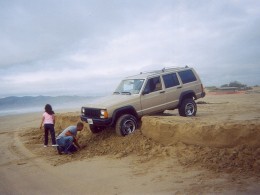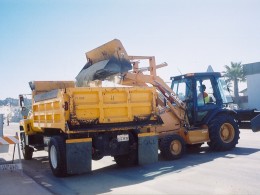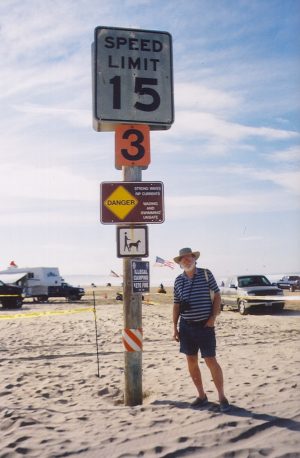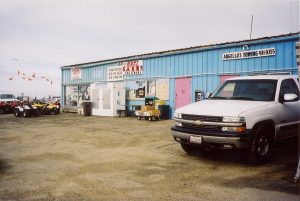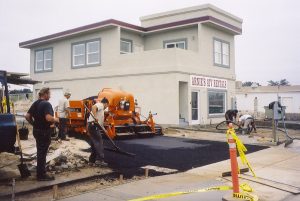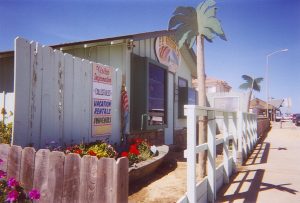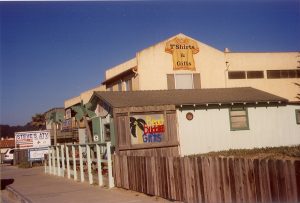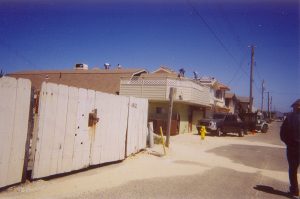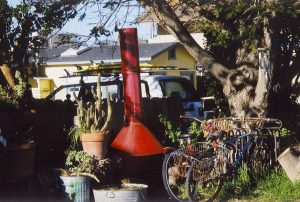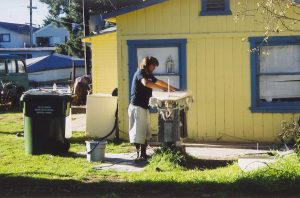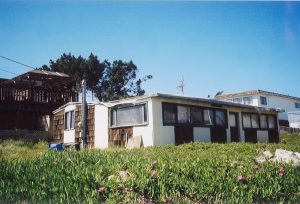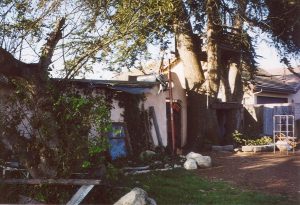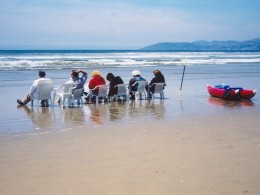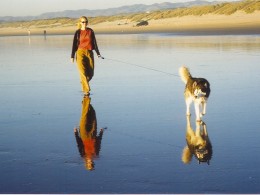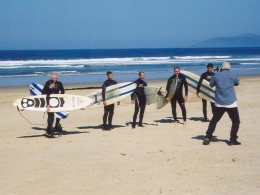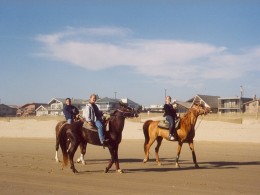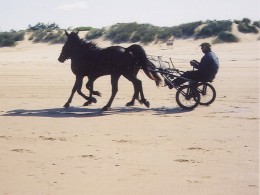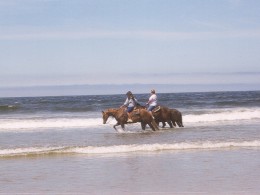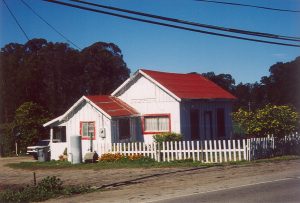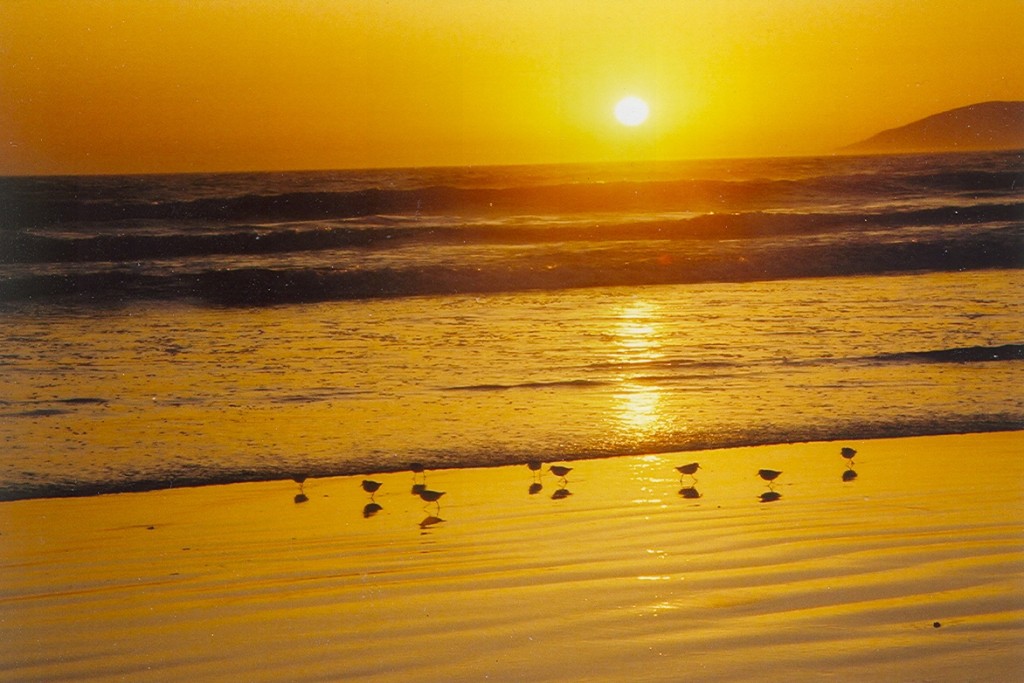New Years Eve, and the street is filling up with revelers. This is Pier Avenue, a four-lane road about 1/4 mile long, between Rte. 1 and the beach. Just before you get to the sand there is a kiosk where state park rangers collect the user fees for people wanting to use the beach. Both traffic lanes headed for the ocean are full, though not as bad as at Thanksgiving, when the lines stretched halfway to the highway.
On any weekend there is a double line of big-wheeled trucks and long trailers with dozens of ATVs stacked up, eight-foot flag antennae whipping in the breeze, waiting to pay the $6 camping or $4 day use fees. Also lots of RVs, including a fairly new kind of trailer that Lee and I looked at before we bought this present Beast. These are probably the longest trailers being pulled by private parties, because the back half is essentially a garage. The rear wall turns into a ramp, and you can drive your off-roader up inside.
We are currently parked 500 feet from one of two entrances to the Oceano Dunes State Vehicular Recreation Area. This means you can actually drive your car onto the beach, and bring along your motorcycle or ATV. This is the only place in California where you can still do that. It didn’t surprise me at all to learn this is a controversial practice. In fact, though the camping/recreation area is incredibly noisy, if you listen carefully you can hear the sound of bricks being squeezed from the rectums of every tree-hugger in California …
Oceano Dunes has a history of being a little different. During the ‘30s and ‘40s this was the home of a lot of people described as free-thinkers: mystics, artists, writers, nudists, and hermits, collectively known as Dunites. Pretty racy, for the ‘30s. Ella Young, a leader (if such a group can be said to have a leader), named the place Moy Mell, which means “pasture of honey” or “where the spirits dwell” in Gaelic. Or maybe it means “pasture of sticky spirits.”
About a mile down the beach from here you can dry camp: no power, no water, no sewer hookups. Holiday weekends are booked to capacity months ahead. It is a little eerie to go down there. As late as midnight, I’ve seen the headlights stretched up and down the wide sandy beach, driving back and forth. These are car people, no doubt of it.
Until 1982 there were 15,000 acres in the ODSVRA. Now it is 1300 acres, and the environmentalists who shut down 90% in 1982 but promised they didn’t want to shut it ALL down … almost succeeded in doing just that twice this year. The little community of Oceano Dunes is reeling, trying to get organized, hoping to convince the people who matter that things are being managed well as they are.
See, two threatened birds, the California least tern and the western snowy plover dig pathetic little hollows in the sand above the high tide line between March and September and call them nests. Though the nesting areas are fenced off during those times, it is easy for me to believe that a few ignorant yahoos plowing through the sand could crush a lot of eggs, not to mention the anxiety the noisy little buggers surely inflict on the mother hens who don’t dare move, come snakes, rats, hawks, high water, or juvenile anarchist motorbikers.
Let me say up front that I consider myself to be a tree-hugger, mostly. I don’t much like ATVs, dune buggies, hummers, “personal watercraft,” or snowmobiles except those used as emergency vehicles. They are noisy, oily, and smelly, and they disrupt the serenity of the environments they invade and the safety of more sedate users of beaches, lakes, forests, and rivers. If I ran things I’d immediately ban ALL of them with 2-stroke engines, which dump 30% of their fuel right into the atmosphere. You want to go off-roading, get a rig with a less polluting engine. However …
There are 1100 miles of California coast. You can drive on precisely five miles of that shoreline. It doesn’t seem like a lot to set aside.
But we all know there are those in the environmental movement who never compromise, never give any quarter, never take any prisoners. They are still very much in the ascendant, especially on bodies like the California Coastal Commission, despite a growing (and often misguided) citizen backlash.
You know, I don’t think the old Dunites would have been wild about the off-roaders, either … but I somehow know they would never dream of making a fuss about them unless they drove through their marijuana patches. Such Bohemian communities traditionally mind their own business. They don’t like a lot of new laws, and believe me, off-roaders face almost as much in the way of regulation as if they were cruising down I-5. The new denizens of Oceano Dunes (I think of them as Doonies, or Xtreme Doonies, in keeping with the times) just want to be left alone on this one small stretch of sand.
I don’t think they will be. I wouldn’t be surprised if this entire scene was gone by this time next year.
And in California, of all places! California, whose stewardship of the coast is pathetic. You don’t believe me? Then drive north out of Santa Monica and behold ye the Great Wall of Malibu. Park, if you can find a place. Now try to get to the sand. Bring along a bulldozer, it’ll help. You’ll find a solid barrier of wood and concrete block walls. My understanding is that, theoretically, beachfront property owners in California have to provide access to the public. But in practice … “Hey, screw you, I paid ten million dollars for this shack!” It’s more or less the same up and down the California coast.
Try to get to the beach in Oregon, and you’ll have no problem. You cannot block beach access in Oregon. You can’t even put up a cyclone fence.
My solution? Simple. You property owners can keep on staying in your houses, but all the “privacy” walls have got to come down. And if your house is 2 inches from your neighbor’s, you’ll have to do some remodeling, because people have to be able to walk between ALL houses. But … you CANNOT shore up your house more than it already is. You can’t do anything to alter the beach: bulldoze sand or dump loads of rock as a breakwater. And when a storm washes your house into the sea … the state or the feds will NOT help you rebuild. Instead, you get to stand and watch, and then you get to pay for hauling away the debris. In a few decades California would have pretty beaches you could SEE again, and open to all.
Don’t hold your breath. Who do you think pays the campaign expenses of the people who appoint the CCC? The movers and shakers of Malibu, that’s who. And who gets the shaft? The Doonies, who are as working-class a bunch as you would ever see at a NASCAR race in Alabama, and not one in 1000 of whom would know a snowy plover from a four-leaf clover. So screw ’em, right?
The town of Oceano clings like an unwanted barnacle to the underside of what they call the Five Cities Area: Pismo Beach, Shell Beach, Grover Beach (which doesn’t actually have much beach, and no grovers to speak of), Arroyo Grande, and Oceano. You don’t usually know you’ve left one town and entered another unless you see a city limits sign. But Oceano is a little different. It is definitely cheaper, and more working class. I’d say 50% of the population is Hispanic. They don’t seem impoverished. They drive decent cars, their homes are low rent but not terrible. Just south of Oceano’s main drag, Cienaga Street, it is mostly open fields for about ten miles, into the little town of Guadalupe, in the Santa Maria Valley. Many of the residents of Oceano work in these fields, at wages I must assume are better than they used to be or they wouldn’t be driving those nice cars. (I’m not saying their lives are cushy, it’s terrible work, I’d last about five minutes bending over to pick strawberries.) All the grocery stores and most of the restaurants here are heavily Mexican. There are more tortillas than loaves of bread on the shelves. There are plenty of other specialty Mexican items I don’t know WHAT they are.
The tiny community of Oceano Dunes sits apart from the rest of Oceano, a carbuncle on the barnacle, isolated by state park land and rolling sand dunes. How tiny are we? 2 T-shirt stores, 1 fish and chips shop (seldom open during this off season), 1 Italian bakery (currently remodeling),1 antique shop, 1 liquor store, 2 ATV rentals and one being built, 1 RV park, and 1 salt water taffy store. That’s it, all at the wet end of Pier Avenue.
To the south is a cluster of beach houses. Strand Street, more of an alley, really, parallels the beach, and eight streets intersect it. Behind that is a messy jumble of streets, only a few blocks deep. A social dynamic is clearly visible here, what I think of as the malibuization of California. On the west side of Strand, the actual beachfront side, malibuization is virtually complete. With the exception of half a dozen houses that look to be relics of the ‘50s and ‘60s and a few empty lots (probably soon to be built on), every home appears to have been built sometime in the ‘90s. And they are LARGE homes. Across the street the process is only half finished. On the side streets, that are closer to the marsh than to the sand, it all looks more like what a beach community used to look like. I figure this is the remains of Moy Mell. The old Dunites lived in these structures, which range from what Lee and I would call pleasantly funky, to outright shacks. They are made of weathered wood. Some have a lot of junk in the yard. One is used by a one-legged man who makes surf boards in his front yard.
Our guess is that the land beneath these homes is worth more every year, and in another decade most of them will be gone and Oceano Dunes will be much like the towns of Shell Beach and Pismo Beach to the north, where all the homes within walking distance of the water are big and expensive. That, or large resort-condo-time-share complexes like the ones that already speckle the maps of the northern beach towns. One such complex is already here. Rentals on these properties are WAY beyond the means of “bohemians” … which includes us, parked here in the RV park I’d call “picturesque,” but a real estate developer would call “flea-bitten.” Lee and I figure we were lucky to happen by during this short window of opportunity before malibuization is complete.
Oceano and parts of Arroyo Grande are dotted with fields that still grow crops. No corn or wheat or such here, this area seems to be the nation’s salad bowl. A dozen varieties of lettuce are grown, as well as kale, broccoli, cauliflower, cabbage, rhubarb, artichokes … and I wouldn’t be a bit surprised if they raised arugula, leeks, and bok choy. Much of this stuff is grown in a way I hadn’t been familiar with. They heap the dirt into wide rows with deep furrows between them, then spread out a layer of plastic with holes punched in it. Then they move a big machine with a dozen female field workers sitting on the back slowly down the rows. The women feed seedlings into the machine, which somehow sticks them in the ground. I don’t know how it’s done, but I’d like to see how that machine works. They plant strawberries this way. The strawberry fields in the area seem to go on forever. This region is probably the reason you can get them year-round at the Safeway.
In fact, year-round is sort of the key word for this area. Driving down Hwy 1 to Guadalupe, you can see fields ready to harvest, fields being plowed, fields full of young plants, right across from each other, growing the same crop.
The other major crop is grapes, everything from boutique wineries on hillsides with fancy tasting rooms to vast vineyards in the flatlands producing Bob Packwood-style boxed vintages, (“Was January 2003 a good month?”) liberally mixed with pear wine. I’ll bet California grows more grapes than France.
January 31, 2003
Oceano, CA

